Straight Razors Vs Electric Shavers (Pros, Cons, & Differences)
When in the market for a new razor, a shaver needs to know the differences between each option. What option fits your needs better? What are the differences between a straight razor and an electric shaver?
Other than their ultimate goal of completely shaving a man’s face, a traditional straight razor and a modern electric shaver could not be more different. From the overall design, to how the blades operate, to the types of regular maintenance required, these two types of shaving razors have starkly different features and target users.
Keep reading for a breakdown of the specific differences when comparing the blade, handle, materials, price, value, and learning curve. Once that is covered, discover the pros and cons of each so you can understand which one is the better option.
Differences between a straight razor and electric shaver
When comparing a straight razor and an electric shaver, a shaver will notice that there are numerous differences between the two.
Straight razors and electric shavers are polar opposites of each other. Straight razors are primarily used for wet shaving. An electric shaver is used for dry shaving. Straight razors have a higher cost compared to an electric shaver. A steep learning curve exists when first using a straight razor compared to a minimal one for electric shavers.
An electric shaver is best for daily or frequent shaves, especially when the hair is not thick. Thicker hair can clog the blades, causing the shaver to either burn out or the blades to no longer work. However, it is possible to still achieve a close shave. They also require consistent charging between uses.
A straight razor is known for its ability to provide the closest shave possible. However, the blade will need to be sharpened or replaced as it dulls. Unfortunately, straight razors can increase the risk of injury during use due to the lack of protection between the blade and your skin. With a significant learning curve, a shaver opens themselves up to the risk of injury or skin irritation even more.
With the question of what are the specific differences in mind, let us explore the differences between a straight razor and an electric shaver when it comes to the blade, handle, materials, price, value, and learning curve.
Blade
The blade is the most important part of a straight razor or electric shaver. When considering which one to buy, knowing the ins and outs of both options is necessary.
Straight razors are a single, unprotected, sharp blade intended to give a shaver the closest possible shave.
When used, it is important to make sure the blade remains sharp, otherwise, the results will suffer. Furthermore, without any protection, a shaver can open themselves up to injury or skin irritation when shaving.
Electric shavers have multiple circular blades on the head that rotate and move with the shape of your face.
This works best for daily or regular shaves. Every week or so, you will need to pop open the head of the shaver and empty out the hair. This prevents the hair from clogging up and causing long-term damage to the shaver.
Now that the blades are covered, here are more details regarding the handles of both products.
Handle
The handle of a razor goes a long way when seeking comfort and stability.
Straight razors are much thinner compared to an electric shaver.
A straight razor has grooved metal knurling that is included on the handle for a better grip. When deciding which straight razor to use, it is vital to test out the handle first to see if you like it and whether or not you think it provides an adequate grip. Depending on your hand size, the smaller, thinner handle might cause some difficulty in its maneuverability and decrease overall comfort.
Electric shavers have a thick plastic handle with rubber grips.
Again, it is important to test out the handle before purchasing to see if the grip is to your liking. The handle is thicker compared to a straight razor, and in some cases, about double the size. This is because the battery and power system is located in the handle, adding to its girth. This benefits someone with larger hands as it makes it less difficult to hold. This goes a long way in overall comfort and maneuverability as you guide the shaver around your face.
Handles are important, but so is the next item on the list, the materials from which each product is made.
Materials
Overall construction and durability are important factors when it comes to the quality of a product.
Straight razors are made of titanium or brass, making it durable, lightweight, and easy to clean.
The blade’s effectiveness relies on its sharpness, so continuous maintenance of the blades is required. The material in which the handle and head are made from makes it easy to clean off, but regular maintenance is needed to prevent future problems.
Electric shavers are made of plastic, less durable, and lightweight.
The head of the shaver often pops open, making it easy to clean out the excess hair from under the blades. This is important because, over time, the excess hair can clog up the blades, making it more difficult to shave, or worse, cause the shaver to eventually burn out. Every couple of days, it is important to do this, but the task itself only takes a few minutes. In addition, an electric shaver usually runs on a chargeable battery, meaning a shaver must charge it in between uses.
With an understanding of how the materials factor into maintenance and usage, here is a breakdown of the price.
Price
Overall, price is important for a shaver. When searching for a product, the cost, and what is included with that price, weigh heavily on a purchasing decision.
Straight razors are one of the most expensive products on the shaving market.
A mid-grade straight razor set up costs around $200-$300 with annual maintenance costs adding another $50-$100 to that initial cost. With this high cost, the cost per shave breakdown is expensive, so if you are not expecting to shave often, this is not the best fit for you.
Electric shavers are much more cost effective.
A high-grade electric shaver runs between $100-$200, with multiple great options in the $50-$100 range. In addition, electric shavers often include other trimmers or attachments for sideburns, neck, nose hairs, and eyebrows. These are rarely if ever included with a straight razor.
Knowing the price of a straight razor or electric shaver are important, but understanding the long-term value of each is equally as important.
Value
The long-term cost and value are important to know as they can impact the purchasing decision as much as the initial cost can.
Straight razors are the more expensive product and require additional maintenance costs that can add up fast.
In addition, the cost to replace the entire setup if it breaks or loses its effectiveness can hurt your wallet. Overall, if you plan to shave often and have money to spend, a straight razor is the best fit.
Electric shavers are about half the cost of a straight razor and have minimal maintenance costs.
They often have additional shaving products included in the initial purchase. If an electric shaver breaks within a year, the overall cost for both the first and second electric shaver is equal to the initial cost of a straight razor. This gives a shaver some wiggle room in case they do not like the first one, or it burns out fast. If you are looking for a cost-friendly, but still effective product, the electric shaver is the best fit.
With the long-term value in mind, let us explore what it takes to learn how to use each product and the difficulty level of doing so.
Learning curve
When using either a straight razor or an electric shaver, there is a unique learning curve.
Straight razors are the most difficult razor to learn how to use.
There is a built-in danger involved that can cause injury or skin irritation, so the technique is important. Unfortunately, it can take upwards of 20 or 30 shaves before the technique is learned and a shaver feels fully comfortable using a straight razor.
Electric shavers are much easier to use and the technique matters less.
With its safety design, there is very little risk of injury, but the risk of skin irritation still exists. Within a few shaves, a shaver will feel confident in using an electric shaver. In that time frame, the technique needed to avoid pulling the hair instead of shaving will be learned. Overall, the learning curve is close to non-existent when compared to that of a straight razor.
With a newfound understanding of how the components differ between a straight razor and an electric shaver, let us find out which one is better and further explore the pros and cons of each.
Are straight razors better than electric shavers?
With all the differences between the two razors, shavers want to know, are straight razors better than electric shavers?
Generally, it comes down to the preference of the shaver when determining which one is better. If a shaver is looking for the closest possible shave and does not mind the steep learning curve, then a straight razor is the best fit. If a shaver is looking for a close shave and wants a minimal learning curve, then an electric shaver is the best fit.
Here are some pros and cons for both a straight razor and an electric shaver:
Pros
Straight razors have a solid (and growing!) following because they deliver the closest, simplest shave. Electric razors are more convenient and are designed for men who want to get their shave over with, not make it an experience.
Straight razors
- provide the closest possible shave
- do not require charging before use
- are easier to clean
Electric shavers
- have a minimal learning curve
- have minimal maintenance
- have low starting cost
Cons
Straight razors are much more difficult to get into due to the steep learning curve and high cost of entry. Electric shavers do not provide a smooth, long-lasting shave and can burn out.
Straight razors
- have a steep learning curve
- have a high starting cost
- require a lot of maintenance
Electric shavers
- shavers can pull on the hair when shaving
- do not provide the closest possible shave
- can clog and burn out







